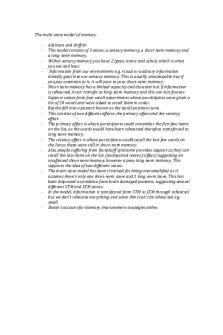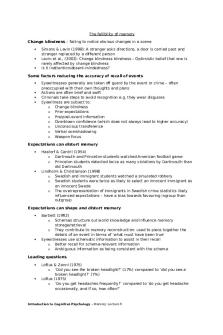The multi store model of memory PDF

| Title | The multi store model of memory |
|---|---|
| Course | Advanced Psychology |
| Institution | Birmingham City University |
| Pages | 2 |
| File Size | 29.9 KB |
| File Type | |
| Total Downloads | 49 |
| Total Views | 141 |
Summary
366 words on the Multi Store model of memory...
Description
The multi store model of memory -
-
-
-
-
-
Atkinson and shiffrin This model consists of 3 stores; a sensory memory, a short term memory and a long-term memory. Within sensory memory you have 2 types; iconic and echoic which is what you see and hear. Information from our environment e.g. visual or auditory information initially goes into our sensory memory. This is usually unnoticeable but if you pay attention to it, it will pass to your short-term memory. Short-term memory has a limited capacity and duration but if information is rehearsed it can transfer to long-term memory and this can last forever. Support comes from free recall experiments where participants were given a list of 20 words and were asked to recall them in order. Results fell into a pattern known as the serial position curve. This consists of two different effects: the primacy effect and the recency effect. The primacy effect is where participants could remember the first few items on the list, as the words would have been rehearsed therefore transferred to long-term memory. The recency effect is where participants could recall the last few words on the list as these were still in short-term memory. Also, people suffering from Korsakoff syndrome provides support as they can recall the last items on the list (unimpaired recency effect) suggesting an unaffected short-term memory however a poor long-term memory. This supports the idea of two different stores. The multi store model has been criticised for being oversimplified as it assumes there’s only one short-term store and 1 long-term store. This has been disproved as evidence from brain damaged patients, suggesting several different STM and LTM stores. In the model, information is transferred from STM to LTM through rehearsal but we don’t rehearse everything and some thins can’t be rehearsed e.g. smell. Doesn’t account for memory improvement strategies either.
The Working Memory Model: - Baddeley and Hitch - Central executive is the key component and can be describes as attention. It has a limited capacity and controls 2 slave systems which also have a limited capacity. - There is the articulatory phonological loop which consists of the phonological store and the articulatory process. - The second system is the visuo-spatial sketchpad...
Similar Free PDFs

The multi store model of memory
- 2 Pages

Working memory model
- 3 Pages

Lecture 5 APT and Multi Factor Model
- 35 Pages

The effect of mood on false memory
- 13 Pages

Tulving - chapter: the memory
- 1 Pages

CH 9 - The Paradox of Memory
- 2 Pages

The ABC model of Attitudes
- 8 Pages

Long-Live-the-Store article
- 8 Pages

Types of Non-Store Retailing
- 2 Pages
Popular Institutions
- Tinajero National High School - Annex
- Politeknik Caltex Riau
- Yokohama City University
- SGT University
- University of Al-Qadisiyah
- Divine Word College of Vigan
- Techniek College Rotterdam
- Universidade de Santiago
- Universiti Teknologi MARA Cawangan Johor Kampus Pasir Gudang
- Poltekkes Kemenkes Yogyakarta
- Baguio City National High School
- Colegio san marcos
- preparatoria uno
- Centro de Bachillerato Tecnológico Industrial y de Servicios No. 107
- Dalian Maritime University
- Quang Trung Secondary School
- Colegio Tecnológico en Informática
- Corporación Regional de Educación Superior
- Grupo CEDVA
- Dar Al Uloom University
- Centro de Estudios Preuniversitarios de la Universidad Nacional de Ingeniería
- 上智大学
- Aakash International School, Nuna Majara
- San Felipe Neri Catholic School
- Kang Chiao International School - New Taipei City
- Misamis Occidental National High School
- Institución Educativa Escuela Normal Juan Ladrilleros
- Kolehiyo ng Pantukan
- Batanes State College
- Instituto Continental
- Sekolah Menengah Kejuruan Kesehatan Kaltara (Tarakan)
- Colegio de La Inmaculada Concepcion - Cebu






